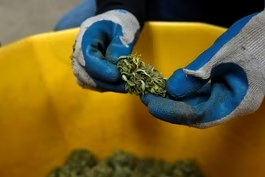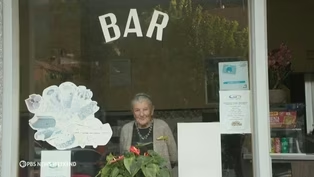
Questions linger a year after BioLab’s toxic fire in Georgia
Clip: 11/16/2025 | 6m 56sVideo has Closed Captions
Questions linger in a Georgia town more than a year after the toxic BioLab fire
Last September, a chemical fire in Conyers, Georgia, sent a toxic cloud over the area. A Georgia Public Broadcasting podcast called “Manufacturing Danger: The BioLab Story” examined that day, what led up to it, and the immediate aftermath. Now, a second season of the podcast looks at health consequences for residents a year later. John Yang speaks with GPB’s Pamela Kirkland for more.
Problems playing video? | Closed Captioning Feedback
Problems playing video? | Closed Captioning Feedback
Major corporate funding for the PBS News Hour is provided by BDO, BNSF, Consumer Cellular, American Cruise Lines, and Raymond James. Funding for the PBS NewsHour Weekend is provided by...

Questions linger a year after BioLab’s toxic fire in Georgia
Clip: 11/16/2025 | 6m 56sVideo has Closed Captions
Last September, a chemical fire in Conyers, Georgia, sent a toxic cloud over the area. A Georgia Public Broadcasting podcast called “Manufacturing Danger: The BioLab Story” examined that day, what led up to it, and the immediate aftermath. Now, a second season of the podcast looks at health consequences for residents a year later. John Yang speaks with GPB’s Pamela Kirkland for more.
Problems playing video? | Closed Captioning Feedback
How to Watch PBS News Hour
PBS News Hour is available to stream on pbs.org and the free PBS App, available on iPhone, Apple TV, Android TV, Android smartphones, Amazon Fire TV, Amazon Fire Tablet, Roku, Samsung Smart TV, and Vizio.
Providing Support for PBS.org
Learn Moreabout PBS online sponsorshipJOHN YANG: On a September morning last year, a chemical fire at a Conyers, Georgia facility operated by Biolab to make chlorine products for swimming pools and hot tubs sent a toxic cloud over the area.
A Georgia public broadcasting podcast called Manufacturing Danger, the BioLab Story examined that day, what led up to it and the immediate aftermath.
JEAN SADLER: That Sunday, 7:00 in the morning, they're banging on our door.
You got to evacuate.
What?
You got to get out.
It is a fire.
So we're thinking, oh, okay, they'll have it under control by 5 o'clock.
So we go to the church, and we sat at the church for all those hours.
So finally we realized we can't go home.
JOHN YANG: Now a second season of the podcast hears from whistleblowers and looks at the health consequences residents are experiencing a year later and what could have been done to prevent it.
Georgia Public Broadcasting's Pamela Kirkland reported and hosts both seasons of the podcast.
Pam, walk us through what happened that morning in Conyers.
PAMELA KIRKLAND, Host, Georgia Public Broadcasting: So September 29, 2024, two BioLab employees call 911 because they realize there's a chemical reaction happening in the building that turn into a fire.
And later that day, that fire produces a toxic chemical plume that spreads over Conyers and the surrounding area.
For those of you who don't know, Conyers is a suburb of Atlanta.
So it's about 30 minutes away.
And people were complaining about a haze and a smell of chlorine for days afterwards.
The fire and the plume triggered evacuations, shelter in place orders.
And you heard from Jean Sadler earlier.
She's one of those who was forced to evacuate.
She lived in Conyers for about 50 years and says that she suffered health issues as a result of the fire.
JOHN YANG: You followed some of those residents you just talked about.
What are some of their stories?
PAMELA KIRKLAND: Sure.
So, Sheryl Garcia is another person that I've been in touch with for about a year.
She's a retired nurse practitioner and actually knows a lot about chemicals on her own.
But she talked about how she used to have asthma.
It's been under control for about a decade.
But in the days and weeks after the fire, those asthma symptoms came back and it got so bad that her voice, she called it her BioLab voice because it was so raspy.
She went to speech therapy for it after an ENT examined her and said that while they couldn't attribute what she was suffering from to the fire, they could say that there was some damage to her vocal cord.
So she's been on different medications since and in therapy trying to improve that.
And you know, residents have talked about a number of different symptoms, but you hear patterns.
A lot of people complained about migraines, shortness of breath, irritation, things like that, things that would be symptomatic of chlorine exposure.
JOHN YANG: In one of the episodes of the podcast, you play a 911 tape from the day of the fire.
We hear someone on the tape say it's always BioLab.
What did you learn about the history of that facility and previous incidents of that facility?
PAMELA KIRKLAND: Looking into BioLab's record, we found fires in 2004.
We found another fire in 2015 that prompted some voluntary evacuations, one in 2016 where several firefighters were injured, and another one in 2020 that produced a chemical plume.
Now, the most recent fire, 2024, the company's come under a lot of scrutiny because of.
And there have been a lot of questions as to how this could happen so many times because the details between them have been so similar.
It's always a chemical that's supposed to stay dry gets wet.
A chemical reaction occurs, and it sparks a fire or a large plume of chemical smoke.
So OSHA and the EPA have oversight over companies like this, companies that store large quantities of chemicals.
But what we found is that there's a regulatory gap.
So the chemical that BioLab stores is not under the same kind of oversight that a chemical like chlorine would be, or other more serious chemicals that we're a little more familiar with.
We're talking about something called TCCA, which is involved in making products that clean pools and spas.
So it's a little bit more obscure than, you know, your everyday chlorine.
JOHN YANG: Are there lessons here for other communities that may have these facilities in them?
PAMELA KIRKLAND: So I think the biggest takeaway, residents would say, is that there should be a plan in place.
There were a lot of questions on the local level about how county officials responded to this, how the city of Conyers responded to this BioLab fire.
As there were 19,000 evacuations, 70,000 people were told to shelter in place.
But that day, it was so hard to get out and to get to safety that you were almost stuck.
You were underneath the plume, even though you didn't want to be.
What we've also seen is this network of communities that have come together.
East Palestine, Ohio, the train derailment that happened there in 2023, there were actually residents from there that came to Conyers just to show solidarity and say, hey, we've been through a chemical disaster.
If you have any questions, you can ask us.
If on the federal level, local level, state level, we feel like we're not getting the help and support that we need, at least we can build this network for each other.
JOHN YANG: One of the agencies that investigated this was the U.S.
Chemical Safety Board.
The administration wants to zero that out.
They want to eliminate that.
What effect would that have on towns like Conyers and other places that may have similar facilities?
PAMELA KIRKLAND: So a lot of the details about what happened that day on September 29, 2024, came from the U.S.
Chemical Safety Board's investigations.
They've produced two updates thus far, but we don't have the final investigation quite.
We still don't have a cause of the fire, actually.
And so agencies like the EPA and OSHA take what the CSB does very seriously because they are kind of that independent watchdog.
They can make recommendations.
They can't actually force a company to change how they store chemicals, for example, but they can make suggestions.
They've been suggesting that regulatory gap that we talked about a little bit earlier be closed for decades.
Without the CSB, you don't really have another agency that investigates chemical accidents like this.
Their job is to be a watchdog over the OSHA and EPA.
And yet in the budget request for fiscal year 2026, it says that OSHA and EPA can do the job that the CSB is doing.
So I think we really wouldn't know a lot about what happened here in this case, in the case of East Palestine, Ohio, and other chemical disasters that we've seen over the years if the CSB is no longer investigating.
JOHN YANG: Pamela Kirkland of Georgia Public Broadcasting, thank you very much.
PAMELA KIRKLAND: Thank you for having me.
How new legislation may threaten the hemp industry’s future
Video has Closed Captions
Clip: 11/16/2025 | 5m 27s | How the bill that ended the shutdown could threaten the U.S. hemp industry’s future (5m 27s)
Italy’s oldest barista, who has served coffee since WWII, turns 101
Video has Closed Captions
Clip: 11/16/2025 | 1m 52s | Italy’s oldest barista, who has served coffee since WWII, turns 101 (1m 52s)
News Wrap: Border Patrol makes more arrests in Charlotte
Video has Closed Captions
Clip: 11/16/2025 | 3m 25s | News Wrap: Border Patrol agents make more arrests on 2nd day of Charlotte surge (3m 25s)
Takeaways from COP30 halfway through the UN climate summit
Video has Closed Captions
Clip: 11/16/2025 | 5m 45s | Key takeaways from COP30 halfway through the UN climate summit (5m 45s)
Providing Support for PBS.org
Learn Moreabout PBS online sponsorship
- News and Public Affairs

FRONTLINE is investigative journalism that questions, explains and changes our world.

- News and Public Affairs

Amanpour and Company features conversations with leaders and decision makers.












Support for PBS provided by:
Major corporate funding for the PBS News Hour is provided by BDO, BNSF, Consumer Cellular, American Cruise Lines, and Raymond James. Funding for the PBS NewsHour Weekend is provided by...



